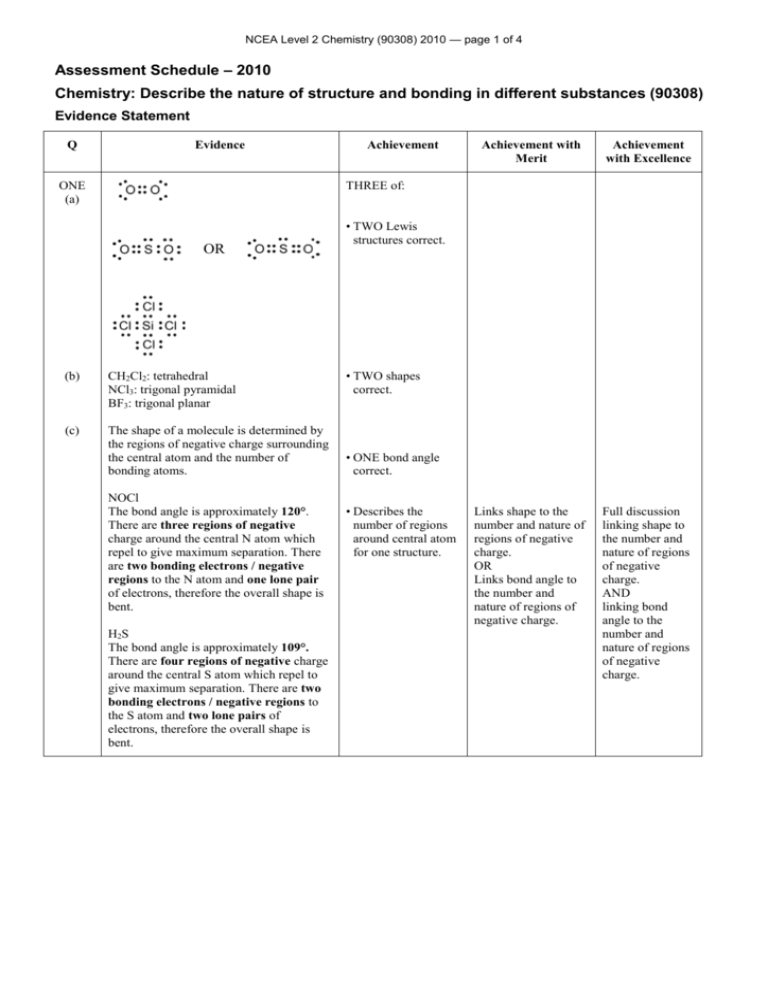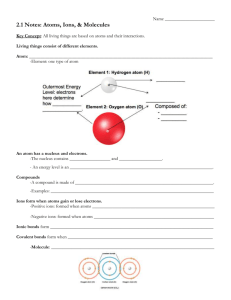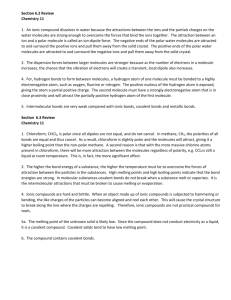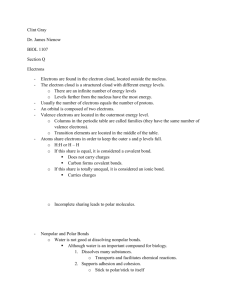86KB - NZQA
advertisement

NCEA Level 2 Chemistry (90308) 2010 — page 1 of 4 Assessment Schedule – 2010 Chemistry: Describe the nature of structure and bonding in different substances (90308) Evidence Statement Q Evidence ONE (a) Achievement Achievement with Merit Achievement with Excellence Links shape to the number and nature of regions of negative charge. OR Links bond angle to the number and nature of regions of negative charge. Full discussion linking shape to the number and nature of regions of negative charge. AND linking bond angle to the number and nature of regions of negative charge. THREE of: OR (b) CH2Cl2: tetrahedral NCl3: trigonal pyramidal BF3: trigonal planar (c) The shape of a molecule is determined by the regions of negative charge surrounding the central atom and the number of bonding atoms. NOCl The bond angle is approximately 120°. There are three regions of negative charge around the central N atom which repel to give maximum separation. There are two bonding electrons / negative regions to the N atom and one lone pair of electrons, therefore the overall shape is bent. H2S The bond angle is approximately 109°. There are four regions of negative charge around the central S atom which repel to give maximum separation. There are two bonding electrons / negative regions to the S atom and two lone pairs of electrons, therefore the overall shape is bent. • TWO Lewis structures correct. • TWO shapes correct. • ONE bond angle correct. • Describes the number of regions around central atom for one structure. NCEA Level 2 Chemistry (90308) 2010 — page 2 of 4 TWO (a)(i) (ii) TWO of: Stream of water is deflected. Stream of cyclohexane is not deflected. The polar water molecules are affected by the charged ruler (unlike charges attract). This causes the stream of water to be deflected towards the charged ruler. The non-polar cyclohexane molecules are not affected by the charged ruler; therefore the cyclohexane flows without being deflected. Correct observations for both liquids. Links observations to polarity of water molecule (or non polarity of cyclohexane molecule) EITHER (b)(i) (ii) CH3Cl: polar CCl4: non-polar NH3: polar Molecules are polar if there is an uneven spread of charge over the molecule. In CH3Cl, the polarity of the C–H bonds and the C–Cl bonds is different; due to differences in electronegativity (the C–Cl bonds are more polar). Therefore the charges are not spread evenly around the central C atom / the dipoles do not cancel, and the molecule is polar overall. In NH3, the N–H bonds are polar due to differences in electronegativity / dipoles of N and H. The three polar N–H bonds are not spread symmetrically around the trigonal pyramid shaped molecule, due to the lone pair of electrons, therefore the molecule is polar. Non-polar molecules arise when there are no polar bonds present in the molecule or the spread of charge is even. In CCl4, the C–Cl bonds are polar, due to differences in electronegativity of C and Cl. However, four C–Cl bonds are arranged symmetrically in a tetrahedral shape, and the charges are spread evenly, resulting in a non-polar molecule. TWO polarities correct. OR Description of polar molecules, eg polar molecules contain polar bonds / polar molecules have an uneven spread of charge (non-polar molecules have an even spread of charge) / have + and - end. Description of polar bonds in terms of electronegativity differences between atoms. AND Links polarity of molecule to shape OR symmetry of polar bonds. Full discussion which links polarity of molecule to shape and symmetry of polar bonds or dipoles for at least two out of the three molecules. NCEA Level 2 Chemistry (90308) 2010 — page 3 of 4 THREE (a) (b) MgCl2 is made up of ions SiO2 is made up of atoms. Both solids have a high melting point. MgCl2 has a high melting point. It is an ionic solid. It consists of a 3–D lattice of positive Mg2+ ions and Cl– ions and the ions are held together by strong ionic bonds. As a lot of energy is required to overcome these strong bonds to separate the ions, the solid has a high melting point. SiO2 is a covalent network solid. The atoms in SiO2 are held together by strong covalent bonds. A lot of energy is required to break these bonds in order for the solid to melt; therefore it has a high melting point. MgCl2 is soluble in water, whereas SiO2 is not. Water molecules are polar. When MgCl2 is placed in water, the oxygen ends of the water molecules are attracted to the positive Mg2+ ions, and the hydrogen ends of the water molecules are attracted to the negative Cl– ions. The water molecules then pull ions from/destroy the lattice, resulting in the solid dissolving. THREE of: • Particles correct for both solids. • MgCl2 is an ionic solid. OR SiO2 is a covalent network solid. • Attractive forces between particles described for either MgCl2 or SiO2. • States that melting point is related to nature and strength of attractive forces between particles. • States that solubility is related to nature and strength of attractive forces between particles. Melting point or solubility correctly linked to particles and attractive forces for both solids, OR Melting point and solubility correctly linked to particles and attractive forces for one solid. BOTH physical properties (melting point and solubility) fully discussed with reference to particles, type of solid and the attractive forces between particles for both solids. SiO2 is not soluble in water, as the covalent bonds are too strong to be broken by the attraction to the water molecules. FOUR (a) (b) A: (loosely held) valence electrons / delocalised electrons B: atoms / positive ions / cations / positive kernel (of the metal atom) Copper is composed of Cu atoms /cations (NOT protons or nuclei) held together in a 3–D lattice by metallic bonding, in which valence electrons are attracted to the nuclei of neighbouring atoms. The delocalised electrons / valence electrons are free to move through the lattice; therefore they are able to conduct electricity. The attraction of the Cu atoms for the valence electrons is not in any particular direction; therefore Cu atoms can move past one another, and so Cu is ductile and can be drawn out into wires without breaking. TWO of: • ONE label correct. • EITHER attractive forces in Cu described. OR Bonding in Cu is non-directional. • EITHER Electrons in Cu are free to move. OR Free-moving charged particles are required for electrical conductivity. ONE property linked to the structure of copper and the nature of the metallic bond. BOTH properties fully discussed and linked to the structure of copper and the nature of the metallic bond. NCEA Level 2 Chemistry (90308) 2010 — page 4 of 4 Judgement Statement Achievement Achievement with Merit Achievement with Excellence 3A 3M 3E









